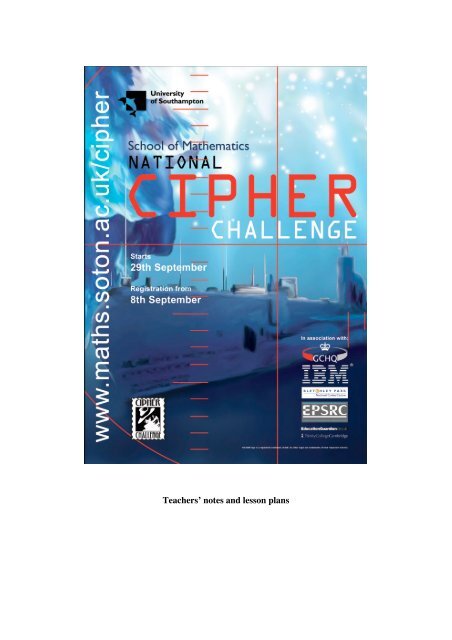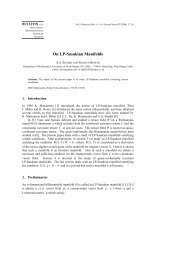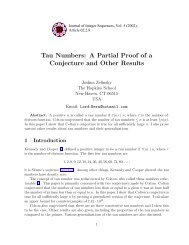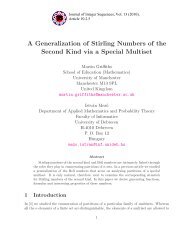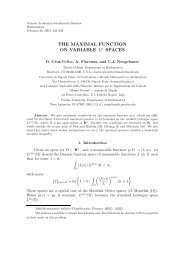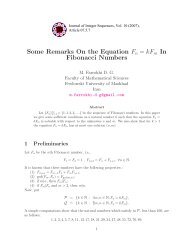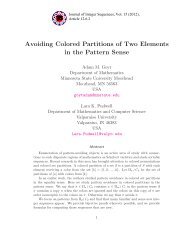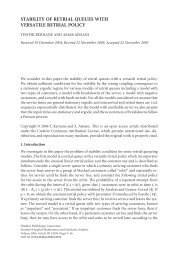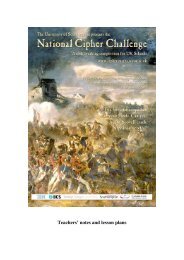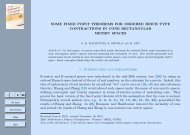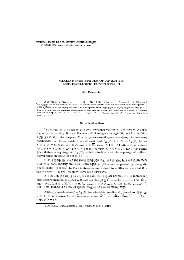Teachers' notes and lesson plans - University of Southampton
Teachers' notes and lesson plans - University of Southampton
Teachers' notes and lesson plans - University of Southampton
Create successful ePaper yourself
Turn your PDF publications into a flip-book with our unique Google optimized e-Paper software.
Teachers’ <strong>notes</strong> <strong>and</strong> <strong>lesson</strong> <strong>plans</strong>
On substitution ciphers<br />
Graham A. Niblo<br />
<strong>University</strong> <strong>of</strong> <strong>Southampton</strong> National Cipher Challenge 2005<br />
These <strong>notes</strong> form a brief introduction to substitution ciphers,<br />
to accompany the <strong>lesson</strong> <strong>plans</strong> provided with the <strong>University</strong> <strong>of</strong> <strong>Southampton</strong> National<br />
Cipher Challenge, 2005. We would like to thank Hugh Evans <strong>of</strong> Sholing City<br />
Technology College for his assistance in the design <strong>of</strong> these teaching materials.<br />
Caesar shift ciphers<br />
The easiest method <strong>of</strong> enciphering a text message is to replace each character by<br />
another using a fixed rule, so for example every letter a may be replaced by D, <strong>and</strong><br />
every letter b by the letter E <strong>and</strong> so on.<br />
Applying this rule to the previous paragraph produces the text<br />
WKH HDVLHVW PHWKRG RI HQFLSKHULQJ D WHAW PHVVDJH LV WR<br />
UHSODFH HDFK FKDUDFWHU EB DQRWKHU XVLQJ D ILAHG UXOH, VR<br />
IRU HADPSOH HYHUB OHWWHU D PDB EH UHSODFHG EB G, DQG<br />
HYHUB OHWWHU E EB WKH OHWWHU H DQG VR RQ.<br />
(Note the convention that ciphertext is written in capital letters, while plaintext is<br />
usually lowercase.)<br />
Such a cipher is known as a shift cipher since the letters <strong>of</strong> the alphabet are shifted<br />
round by a fixed amount, <strong>and</strong> as a Caesar shift since such ciphers were used by Julius<br />
Caesar. To decode a Caesar shift it is enough to work out the amount <strong>of</strong> shift, which<br />
can be done, for example, by discovering which character has replaced the letter e. In<br />
the example above we might guess that the three letter word starting the sentence is<br />
the <strong>and</strong> therefore that the letter e has been replaced by H. A quick check shows that<br />
the Caesar shift by 3 does indeed encode the word the as WKH, <strong>and</strong> it is easy to<br />
complete the decryption.<br />
In fact there are only 26 Caesar shift ciphers (<strong>and</strong> one <strong>of</strong> them does nothing to the<br />
text) so it is not too hard to decipher the text by brute force. We can try each <strong>of</strong> the<br />
shifts in turn on the first word <strong>of</strong> the cipher text until we discover the correct shift.<br />
This process can be simplified by using a cipher wheel, a simple mechanical device<br />
which allows one to generate each <strong>of</strong> the Caesar shift ciphers, <strong>and</strong> to encode or<br />
decode messages using it. At the back <strong>of</strong> this pack you will find a sheet, which can be<br />
photocopied onto thin card in order to make a cipher wheel. Cut out the two discs, <strong>and</strong><br />
fasten through their centres with a paper fastener to make the wheel. Use the<br />
convention that you read plaintext on the outer rim <strong>of</strong> the wheel <strong>and</strong> cipher text from<br />
the smaller wheel.<br />
3
Keyword substitution ciphers<br />
To increase the difficulty <strong>of</strong> deciphering the text we need a richer family <strong>of</strong> ciphers. A<br />
good example is furnished by the keyword cipher. In this we design an encryption<br />
table by choosing a keyword or phrase, which is used to jumble the alphabet as<br />
follows:<br />
Write down the phrase, with no spaces between the letters, <strong>and</strong> omitting any repeated<br />
character. So if the phrase is “The Simpsons” we write down THESIMPON. Now we<br />
continue to go round the alphabet until every letter appears exactly once, <strong>and</strong> write the<br />
list under the st<strong>and</strong>ard alphabet:<br />
abcdefghijklmnopqrstuvwxyz<br />
THESIMPONQRUVWXYZABCDFGJKL<br />
Of course if the key phrase is carefully chosen (for example “The quick brown fox<br />
jumps over the lazy dog”) we may not need to complete the list as above, but such a<br />
choice is not necessary.The number <strong>of</strong> such ciphers is 26!, or approximately 10 27 , <strong>and</strong><br />
brute force cannot be used to attack the problem. However an attack is possible.<br />
Consider the text<br />
VEP HYXHLVHTP MO AWFJYFLT H RFNEPS HJNEHAPV FL VEFU ZHC<br />
FU VEHV FV FU PHUC VM KPKMSFUP VEP IPCZMSY MS IPCNESHUP,<br />
HLY EPLRP VEP RFNEPS HJNEHAPV. VEFU FU FKNMSVHLV, APRHWUP<br />
FO VEP UPLYPS EHU VM IPPN VEP RFNEPS HJNEHAPV ML H NFPRP<br />
MO NHNPS, VEP PLPKC RHL RHNVWSP VEP NHNPS, YFURMXPS VEP<br />
IPC, HLY SPHY HLC RMKKWLFRHVFMLU VEHV EHXP APPL PLRSCNVPY<br />
ZFVE FV. EMZPXPS FO VEP IPC RHL AP RMKKFVVPY VM KPKMSC FV<br />
FU JPUU JFIPJC VM OHJJ FLVM PLPKC EHLYU.<br />
As before we notice that the first word has three letters <strong>and</strong>, since it occurs several<br />
times, may well be the word the. This gives a strong hint that the letter e is<br />
enciphered as the letter P in the keyphrase cipher. Of course other three letter words<br />
are possible, e.g., <strong>and</strong> or but. Nonetheless a quick check shows us that the letter P is<br />
the most common letter in the enciphered text, just as e is the most common letter in<br />
English so it is reasonable to assume that the correct decryption translates P to e. This<br />
also suggest that V st<strong>and</strong>s for t <strong>and</strong> E for h, allowing us to begin to decipher the text.<br />
We will use the convention that uppercase letters denote enciphered letters <strong>and</strong><br />
lowercase de<strong>notes</strong> plaintext characters:<br />
the HYXHLtHTe MO AWFJYFLT H RFNheS HJNhHAet FL thFU ZHC<br />
FU thHt Ft FU eHUC tM KeKMSFUe the IeCZMSY MS IeCNhSHUe,<br />
HLY heLRe the RFNheS HJNhHAet. thFU FU FKNMStHLt, AeRHWUe<br />
FO the UeLYeS hHU tM IeeN the RFNheS HJNhHAet ML H NFeRe<br />
MO NHNeS, the eLeKC RHL RHNtWSe the NHNeS, YFURMXeS the<br />
IeC, HLY SeHY HLC RMKKWLFRHtFMLU thHt hHXe AeeL eLRSCNteY<br />
4
ZFth Ft. hMZeXeS FO the IeC RHL Ae<br />
RMKKFtteY tM KeKMSC Ft FU JeUU JFIeJC tM<br />
OHJJ FLtM eLeKC hHLYU.<br />
Reading carefully we see the single letter word H, <strong>and</strong> the<br />
four letter word thHt in the first line, <strong>and</strong> guess that H<br />
enciphers the letter a. Making that replacement we get:<br />
the aYXaLtaTe MO AWFJYFLT a RFNheS aJNhaAet FL thFU ZaC<br />
FU that Ft FU eaUC tM KeKMSFUe the IeCZMSY MS IeCNhSaUe,<br />
aLY heLRe the RFNheS aJNhaAet. thFU FU FKNMStaLt, AeRaWUe<br />
FO the UeLYeS haU tM IeeN the RFNheS aJNhaAet ML a NFeRe<br />
MO NaNeS, the eLeKC RaL RaNtWSe the NaNeS, YFURMXeS the<br />
IeC, aLY SeaY aLC RMKKWLFRatFMLU that haXe AeeL eLRSCNteY<br />
ZFth Ft. hMZeXeS FO the IeC RaL Ae RMKKFtteY tM KeKMSC Ft<br />
FU JeUU JFIeJC tM OaJJ FLtM eLeKC haLYU.<br />
Now the two 2 letter words Ft FU are probably “it is” meaning that F enciphers “i”<br />
<strong>and</strong> U enciphers “s”. Hence we get:<br />
the aYXaLtaTe MO AWiJYiLT a RiNheS aJNhaAet iL this ZaC<br />
is that it is easC tM KeKMSise the IeCZMSY MS IeCNhSase,<br />
aLY heLRe the RiNheS aJNhaAet. this is iKNMStaLt, AeRaWse<br />
iO the seLYeS has tM IeeN the RiNheS aJNhaAet ML a NieRe<br />
MO NaNeS, the eLeKC RaL RaNtWSe teh NaNeS, YisRMXeS the<br />
IeC, aLY SeaY aLC RMKKWLiRatiMLs that haXe AeeL eLRSCNteY<br />
Zith it. hMZeXeS iO the IeC RaL Ae RMKKitteY tM KeKMSC it<br />
is Jess JiIeJC tM OaJJ iLtM eLeKC haLYs.<br />
Continuing with appropriate guesses (haXe = have, easC = easy <strong>and</strong> so on) we<br />
decipher the text to get the following extract from Simon Singh’s excellent history <strong>of</strong><br />
codes <strong>and</strong> ciphers, The Code Book:<br />
“The advantage <strong>of</strong> building a cipher alphabet in this way<br />
is that it is easy to memorise the keyword or keyphrase,<br />
<strong>and</strong> hence the cipher alphabet. This is important, because<br />
if the sender has to keep the cipher alphabet on a piece<br />
<strong>of</strong> paper, the enemy can capture the paper, discover the<br />
key, <strong>and</strong> read any communications that have been encrypted<br />
with it. However if the key can be committed to memory it<br />
is less likely to fall into enemy h<strong>and</strong>s."<br />
5
Frequency analysis<br />
A more methodical attack is frequency analysis. One counts the number <strong>of</strong><br />
occurrences <strong>of</strong> each character in the cipher text <strong>and</strong> compares it with an expected<br />
frequency for the st<strong>and</strong>ard English alphabet. In the cipher text above a character count<br />
gives us the following table <strong>of</strong> occurrences:<br />
a b c d e f g h i j k l m<br />
7 0 12 0 26 27 0 32 6 9 11 20 18<br />
n o p q r s t u v w x y z<br />
16 5 55 0 14 17 2 17 35 4 4 11 4<br />
Compare this to a table <strong>of</strong> expected frequencies, taken from Simon Singh’s “The<br />
Code Book”:<br />
a b c d e f g h i j k l m<br />
8.2 1.5 2.8 4.3 12.7 2.2 2.0 6.1 7.0 0.2 0.8 4.0 2.4<br />
n o p q r s t u v w x y z<br />
6.7 7.5 1.9 0.1 6.0 6.3 9.1 2.8 1.0 2.4 0.2 2.0 0.1<br />
Using this <strong>and</strong> information about common one, two <strong>and</strong> three letter words we have<br />
enough to begin to tackle the cipher.<br />
Disguising the word structure<br />
The chink in the armour <strong>of</strong> our ciphers so far has been the preservation <strong>of</strong> word<br />
structure. This allows one to spot common words. In order to avoid such weakness<br />
cryptographers usually remove punctuation <strong>and</strong> block the characters together in<br />
groups <strong>of</strong> four or five, so our previous cipher text looks like<br />
VEPHY XHLVH TPMOA WFJYF LTHRF NEPSH JNEHA PVFLV EFUZH<br />
CFUVE HVFVF UPHUC VMKPK MSFUP VEPIP CZMSY MSIPC NESHU<br />
PHLYE PLRPV EPRFN EPSHJ NEHAP VVEFU FUFKN MSVHL VAPRH<br />
WUPFO VEPUP LYPSE HUVMI PPNVE PRFNE PSHJN EHAPV MLHNF<br />
PRPMO NHNPS VEPPL PKCRH LRHNV WSPVE PNHNP SYFUR MXPSV<br />
EPIPC HLYSP HYHLC RMKKW LFRHV FMLUV EHVEH XPAPP LPLRS<br />
CNVPY ZFVEF VEMZP XPSFO VEPIP CRHLA PRMKK FVVPY VMKPK<br />
MSCFV FUJPU UJFIP JCVMO HJJFL VMPLP KCEHL YU<br />
Usually the length <strong>of</strong> the text groups doesn’t matter, however, in analysing a Vigenère<br />
cipher (see below) a carelessly chosen block length may make the length <strong>of</strong> the<br />
keyword more apparent, since it can reveal the repetitions more easily.<br />
6
To attack cipher text that has been grouped in this way we<br />
have to work with letters not words. To do so we use the<br />
frequency analysis described above, together with a little<br />
judgement (or luck!). The process can be hard, but wars<br />
have been won or lost on the back <strong>of</strong> it, <strong>and</strong> so have<br />
fortunes.<br />
“It was hard going, but Jericho didn’t mind. He was taking<br />
action, that was the point. It was the same as code-breaking. However hopeless the<br />
situation, the rule was always to do something. No cryptogram, Alan Turing used to<br />
say, was ever solved by simply staring at it.” From Enigma, by Robert Harris.<br />
Affine shift ciphers<br />
Despite the advantages for an agent in using keyword substitution ciphers most<br />
modern ciphers are automated <strong>and</strong> rely on a mathematical encryption algorithm.<br />
Indeed the Caesar shift cipher can be viewed as just such a cipher:<br />
We start by encoding each letter by its numerical position in the alphabet:<br />
a b c d e f g h i j k l m<br />
1 2 3 4 5 6 7 8 9 10 11 12 13<br />
n o p q r s t u v w x y z<br />
14 15 16 17 18 19 20 21 22 23 24 25 26<br />
Next we shift the alphabet by adding 3 to each position:<br />
a b c d e f g h i j k l m<br />
4 5 6 7 8 9 10 11 12 13 14 15 16<br />
n o p q r s t u v w x y z<br />
17 18 19 20 21 22 23 24 25 26 1 2 3<br />
Of course 24+3 = 27 ! 1, but here we are carrying out modular arithmetic, familiar as<br />
clock arithmetic, so that when we reach 26 we continue from 1.<br />
Finally we replace the numbers with the letters they st<strong>and</strong> for:<br />
a b c d e f g h i j k l m<br />
d e f g h i j k l m n o p<br />
n o p q r s t u v w x y z<br />
q r s t u v w x y z a b c<br />
This recovers the cipher table constructed in <strong>lesson</strong> plan 1 for the Caesar shift by 3.<br />
There is a convenient shorth<strong>and</strong> for the Caesar shift by n, given by x! x+n. It is<br />
confusing since here we are using x to st<strong>and</strong> for the position <strong>of</strong> a letter, <strong>and</strong> n to st<strong>and</strong><br />
7
for the shift amount, i.e., x <strong>and</strong> n are each one <strong>of</strong> the values 1 … 26. It is clear that<br />
since the shift is defined by the integer n there are only 26 Caesar shift ciphers.<br />
There is a bigger class <strong>of</strong> shift ciphers which can be written in these terms known as<br />
the affine shift ciphers, <strong>and</strong> they exploit the fact that we can multiply as well as add<br />
integers in modular arithmetic. It is slightly complicated to set up formally but rather<br />
easy to do in practice so we will work through an example.<br />
The affine shift x! 3x+5<br />
We start as before with the position table, but this time instead <strong>of</strong> replacing a position<br />
x with the number x+3 we will replace it by the number 3x+5, where this number is<br />
interpreted appropriately. So for example 2 ! 3.2+5 = 11, while 8 ! 3.8+5 = 29<br />
which is interpreted as 3 (29=26+3). Whenever the result <strong>of</strong> the computation is larger<br />
than 26 we keep subtracting 26 until it becomes smaller. More formally we compute<br />
3x+5 <strong>and</strong> then take the remainder after division by 26. This yields the table:<br />
a b c d e f g h i j k l m<br />
8 11 14 17 20 23 26 3 6 9 12 15 18<br />
n o p q r s t u v w x y z<br />
21 24 1 4 7 10 13 16 19 22 25 2 5<br />
And from this we recover the encryption table as given on the h<strong>and</strong>out for <strong>lesson</strong> 3:<br />
a b c d e f g h i j k l m n o p q r s t u v w x y z<br />
H K N Q T W Z C F I L O R U X A D G J M P S V Y B E<br />
The affine shift ciphers can also be written in a shorth<strong>and</strong> form x ! ax+b <strong>and</strong> the<br />
Caesar shift ciphers are special cases <strong>of</strong> the affine shift ciphers with a=1.<br />
Now notice that in both the Caesar shift x ! x+3 <strong>and</strong> the affine shift x ! 3x+5 the<br />
letter y is enciphered as B, since 25+3 = 28 = 26+2, <strong>and</strong> 3.25+5 = 80 = 3.26+2. It<br />
follows that two different affine shift ciphers can encrypt a letter in the same way, so<br />
it is no longer sufficient to discover the letter substituting for e in order to decipher<br />
the message. Since there are two degrees <strong>of</strong> freedom in our choice <strong>of</strong> cipher we might<br />
hope that deciphering two letters is sufficient, <strong>and</strong> it is, since, if we know two values<br />
<strong>of</strong> the expression ax+b we can solve the two corresponding simultaneous equations to<br />
find a <strong>and</strong> b.<br />
We may be more familiar with this exercise when solving the equations over the real<br />
numbers, but the same method works for modular arithmetic, with the caveat that in<br />
general we cannot divide. This caveat has an interpretation in cryptography. In order<br />
for the rule x ! ax+b to define a cipher it had better be the case that each <strong>of</strong> the<br />
numbers 1 … 26 appears exactly once in the list <strong>of</strong> numbers ax+b as x ranges from 1<br />
to 26. If we choose a carelessly (so that we can’t divide by a mod 26) this might not<br />
be the case.<br />
8
For example the rule x ! 2x tries to encipher both m <strong>and</strong> z<br />
as Z, since 2.13=26 <strong>and</strong> 2.26 = 52 both <strong>of</strong> which are equal to<br />
26 modulo 26. Such an encryption cannot easily be<br />
deciphered since the recipient <strong>of</strong> the message is unable to<br />
determine whether the sender intended Z to be read as m or<br />
z.<br />
From a mathematician’s point <strong>of</strong> view the enciphering rule<br />
defines a function from the alphabet to itself, <strong>and</strong> this needs an inverse if the cipher is<br />
to be decipherable in a deterministic way. In other words the number theory function<br />
x ! ax+b needs to have an inverse in mod 26 arithmetic. It is a fact from elementary<br />
number theory that it will have such an inverse if <strong>and</strong> only if a is coprime to 26, that<br />
is, their only common divisor is 1.<br />
There are 12 numbers less than 26 <strong>and</strong> coprime to it (those odd numbers not divisible<br />
by 13) so we have 12 possible choices <strong>of</strong> the number a, <strong>and</strong> 26 choices for the number<br />
b, yielding 312 affine shift ciphers. This makes a brute force attack, without<br />
frequency analysis, less practical than the much simpler situation for Caesar shift<br />
ciphers.<br />
Polyalphabetic ciphers<br />
The main weakness allowing us to tackle a substitution cipher is the irregularity in the<br />
distribution <strong>of</strong> letters in English text. Other languages demonstrate similar (though<br />
language specific) irregularities <strong>and</strong> you can find frequency tables for them on the<br />
web.<br />
In order to remove this weakness from a cipher it is necessary to disguise the<br />
frequencies <strong>of</strong> letters in the plaintext <strong>and</strong> the easiest way to do this is by using a<br />
polyalphabetic cipher. In such a cipher each plaintext letter may be encoded in more<br />
than one way so that, for example, the letter e may be enciphered as both X <strong>and</strong> G<br />
within the ciphertext. One problem with this approach is that if X <strong>and</strong> G both encode<br />
for e we don’t have enough letters left to encode the other 25 letters. One elegant<br />
solution to this problem is the famous French cipher known as the Vigenère cipher.<br />
In a Vigenère cipher ANY letter might be encoded by any other; a given Vigenère<br />
cipher uses a subset <strong>of</strong> the 26 possible Caesar shift ciphers. Of course for a genuine<br />
recipient to have any hope <strong>of</strong> deciphering the message there has to be a way to<br />
determine for each cipher character which <strong>of</strong> the shifts has been used. The answer to<br />
this tricky problem is to choose a sequence <strong>of</strong> them known to both parties but to noone<br />
else.<br />
So the two parties might agree to use shifts <strong>of</strong> 22, 9, 7, 5, 14, 5 18, <strong>and</strong> 5 in that order<br />
<strong>and</strong> to continue repeating the pattern for the entire text: 22, 9, 7, 5, 14, 5 18, 5, 22, 9,<br />
7, 5, 14, 5 18, 5, 22, 9 etc..<br />
In order to decode the cipher text the recipient shifts the first cipher character back by<br />
22, the second back by 9 <strong>and</strong> so on to recover the cipher text. Of course the question<br />
remains how one can memorise the correct sequence, but here we borrow an idea<br />
9
from the keyword cipher. The shift numbers 1, …, 26 are taken to st<strong>and</strong> for the<br />
alphabet a, …, z, <strong>and</strong> then the pattern 22, 9, 7, 5, 14, 5 18, 5 spells the word vigenere.<br />
To set up a Vigenère cipher the two parties agree in advance to use the shift pattern<br />
encoded by some agreed keyword or phrase; in our previous Golden Jubilee Cipher<br />
challenge we used a Vigenère cipher based on the keyword GOLD, so characters<br />
were shifted in turn by 7, 15, 12, 4. Such a cipher is very hard to crack.<br />
The method we recommend is due to Babbage <strong>and</strong> Kasiski who independently<br />
discovered it, <strong>and</strong> is based on the regularity <strong>of</strong> the repetition. An analysis <strong>of</strong> repeated<br />
strings <strong>of</strong> letters is used to try to determine the length <strong>of</strong> the keyword, <strong>and</strong> once this is<br />
done a st<strong>and</strong>ard frequency analysis is applied to each part <strong>of</strong> the ciphertext encoded<br />
by a single cipher. A very good account <strong>of</strong> Babbage-Kasiski deciphering can be read<br />
in chapter 2 <strong>of</strong> Simon Singh’s The Code Book.<br />
10
<strong>University</strong> <strong>of</strong> <strong>Southampton</strong> National Cipher Challenge Teachers’ pack<br />
On transposition ciphers<br />
Sometimes when you carry out a frequency analysis you<br />
will find that each letter occurs with about the same<br />
frequency as you would expect in natural English text (or<br />
whichever language you are studying). This is a broad hint that the text is not<br />
enciphered using a substitution cipher, but rather by an anagram or transposition<br />
cipher, also known as an anagram cipher. In such a cipher the letters <strong>of</strong> the message<br />
are not replaced by substitutes, but rather jumbled using some rule which allows them<br />
to be untangled again to decipher the message.<br />
Example<br />
We will encipher the text:<br />
The quick brown fox jumps over the lazy dog<br />
We start with a keyword. Suppose our keyword is BAD. We write it at the head <strong>of</strong> a<br />
table with three columns, then enter the ciphertext in the boxes below. The last,<br />
empty, box is paddded with an X.<br />
B A D<br />
t h e<br />
q u i<br />
c k b<br />
r o w<br />
n f o<br />
x j u<br />
m p s<br />
o v e<br />
r t h<br />
e l a<br />
z y d<br />
o g x<br />
Next we rearrange the columns so that the letters in the keyword are now in<br />
alphabetic order<br />
Lesson plan 1
A B D<br />
H T E<br />
U Q I<br />
K C B<br />
O R W<br />
F N O<br />
J X U<br />
P M S<br />
V O E<br />
T R H<br />
L E A<br />
Y Z D<br />
G O X<br />
Giving a ciphertext <strong>of</strong><br />
HTEUQIKCBORWFNOJXUPMSVOETRHLEAYZDGOX<br />
If the keyword contains repeated letters then we delete them as we would if it were<br />
the keyword for a substitution cipher before constructing the grid. Hence if the<br />
keyword was TOFFEE we would use a grid <strong>of</strong> width 4 with header TOFE <strong>and</strong> we<br />
would rearrange the grid so that its header appeared as EFOT to encipher the<br />
message.<br />
How do we tackle such a cipher<br />
Clearly the length <strong>of</strong> the keyword is quite crucial. You should be able to guess this<br />
from the length <strong>of</strong> the ciphertext, which will be a multiple <strong>of</strong> it. So in our example the<br />
ciphertext has length 36 which has factors 2,3,4,6,9 <strong>and</strong> so on. Hence we could try<br />
laying out the text in grids <strong>of</strong> width 2,3,4,6,9 respectively (a keyword <strong>of</strong> length 12 or<br />
more is unlikely) <strong>and</strong> examining the rows.<br />
Of course a grid <strong>of</strong> width 2 would leave us just switching alternate letters so we<br />
probably don’t need to lay it out that way to check it. Having checked <strong>and</strong> dismissed<br />
the idea <strong>of</strong> a keyword <strong>of</strong> length 2 the first grid we try looks like the second grid<br />
above. Having got to this point the best hope for a quick solution is to find a crib. If<br />
there is a word you think ought to appear in the cipher text then you could try looking<br />
for anagrams <strong>of</strong> that word. This is made difficult by the fact that in splitting the text<br />
into blocks (blocks <strong>of</strong> three in the example), If your crib word does not take up an<br />
entire block then even the characters from the crib that do appear will be jumbled with<br />
other nearby characters, so you need a reasonably long crib. On the other h<strong>and</strong> if it is<br />
too long only part <strong>of</strong> the word will appear in that block so you are looking for<br />
anagrams <strong>of</strong> parts <strong>of</strong> the crib.<br />
In our example if we knew, for some reason, that the text was likely to contain the<br />
word “jumps” we could look for anagrams <strong>of</strong> “jum”, “ump”, “mps. Looking carefully<br />
you should see the anagram PMS in the text <strong>and</strong> we might guess that the first <strong>and</strong><br />
12
<strong>University</strong> <strong>of</strong> <strong>Southampton</strong> National Cipher Challenge Teachers’ pack<br />
second columns have been transposed while the third has<br />
remained fixed. Checking this we find have cracked the<br />
cipher.<br />
Things are harder with longer keywords but the principle<br />
remains the same. Things get tougher if the plaintext is not<br />
in our own language, since it is harder to say what makes<br />
sense. Of course even in this case it may be that part <strong>of</strong> the<br />
message is in your language <strong>and</strong> the rest in another. In this<br />
case you might hope to crack the ciphertext corresponding<br />
to your native language, <strong>and</strong> apply the knowledge that gives you about the cipher to<br />
write down a decrypt <strong>of</strong> the entire message, even when the text is unfamiliar.<br />
Other (subtle) cribs: In English the letters q <strong>and</strong> u occur together so if they are<br />
separated either you are not looking at English text or they should be brought back<br />
together by undoing the anagram.<br />
Numbers <strong>of</strong>ten represent dates, so for example the letters/numbers 2, 1, s, t in<br />
proximity might represent 21 st , while 2,1,t,h might represent 12 th .<br />
Lesson plan 1
Cryptography Lesson Plan 1<br />
Class: Cracking the Caesear shift ciphers.<br />
Resources:<br />
• Leaflet “On substitution ciphers”.<br />
• Two h<strong>and</strong>outs each with a plaintext <strong>and</strong> a cipher table<br />
• Teachers’ solutions for the h<strong>and</strong>outs.<br />
• One OHP slide with cipher text to crack, <strong>and</strong> partial decrypt <strong>and</strong><br />
solution.<br />
Starter: (10 minutes approximately) Uses h<strong>and</strong>outs for Groups A <strong>and</strong> B<br />
Encryption exercise – split the class into groups A <strong>and</strong> B. Give each group the<br />
enclosed text to encipher using the given code. Encourage accuracy AND<br />
secrecy! Answers enclosed with h<strong>and</strong>outs.<br />
Main activity: (40 minutes approx) Uses OHP<br />
• Introduce the idea <strong>of</strong> a substitution cipher in general <strong>and</strong> the Caesar shift<br />
in particular.<br />
• Suggest trial <strong>and</strong> error as a deciphering technique.<br />
• Work through a very simple Caesar shift (by 3).<br />
• Split the class again, swap over the ciphertexts from the starter exercise<br />
<strong>and</strong> get them to tackle them.<br />
Plenary (approx 10 minutes)<br />
Discuss how to make the code harder to crack using a rule that is harder to<br />
determine, but remark on the need for an easy to remember rule (stressed agents<br />
must remember it <strong>and</strong> can’t write it down!) Mention “keyword” substitution.<br />
14
<strong>University</strong> <strong>of</strong> <strong>Southampton</strong> National Cipher Challenge Teachers’ pack<br />
H<strong>and</strong>out for <strong>lesson</strong> 1.<br />
GROUP A<br />
Code: Caesar shift by 2<br />
a b c d e f g h i j k l m n o p q r s t u v w x y z<br />
C D E F G H I J K L M N O P Q R S T U V W X Y Z A B<br />
Plaintext<br />
There were plenty <strong>of</strong> schools in the world, but they were all run either by<br />
the various churches or the Guilds. Miss Butts objected to churches on<br />
logical grounds <strong>and</strong> deplored the fact that the only Guilds that considered<br />
girls worth educating were the Thieves <strong>and</strong> the Seamstresses. It was a big<br />
<strong>and</strong> dangerous world out there <strong>and</strong> a girl could do worse than face it with<br />
a sound knowledge <strong>of</strong> geometry <strong>and</strong> astronomy under her bodice.<br />
From “Soul Music” by Terry Pratchett.<br />
Lesson plan 1
H<strong>and</strong>out for <strong>lesson</strong> 1.<br />
GROUP B<br />
Code: Caesar shift by 4<br />
a b c d e f g h i j k l m n o p q r s t u v w x y z<br />
E F G H I J K L M N O P Q R S T U V W X Y Z A B C D<br />
Plaintext<br />
The four houses are called Gryffindor, Hufflepuff, Ravenclaw <strong>and</strong><br />
Slytherin. Each house has its own noble history <strong>and</strong> each has produced<br />
outst<strong>and</strong>ing witches <strong>and</strong> wizards. While you are at Hogwarts, your<br />
triumphs will earn your house points, while any rule-breaking will lose<br />
house points. At the end <strong>of</strong> the year the house with the most points is<br />
awarded the House Cup, a great honour. I hope each <strong>of</strong> you will be a<br />
credit to whichever house becomes yours.<br />
From “Harry Potter <strong>and</strong> the Philosopher’s Stone” by J.K. Rowling.<br />
16
<strong>University</strong> <strong>of</strong> <strong>Southampton</strong> National Cipher Challenge Teachers’ pack<br />
Teachers’ solutions to encryption challenge<br />
Ciphertext A<br />
VJGTG YGTG RNGPVA QH UEJQQNU KP VJG YQTNF, DWV VJGA YGTG<br />
CNN TWP GKVJGT DA VJG XCTKQWU EJWTEJGU QT VJG IWKNFU.<br />
OKUU DWVVU QDLGEVGF VQ EJWTEJGU QP NQIKECN ITQWPFU CPF<br />
FGRNQTGF VJG HCEV VJCV VJG QPNA IWKNFU VJCV EQPUKFGTGF<br />
IKTNU YQTVJ GFWECVKPI YGTG VJG VJKGXGU CPF VJG<br />
UGCOUVTGUUGU. KV YCU C DKI CPF FCPIGTQWU YQTNF QWV VJGTG<br />
CPF C IKTN EQWNF FQ YQTUG VJCP HCEG KV YKVJ C UQWPF<br />
MPQYNGFIG QH IGQOGVTA CPF CUVTQPQOA WPFGT JGT DQFKEG.<br />
Ciphertext B<br />
XLI JSYV LSYWIW EVI GEPPIH KVCJJMRHSV, LYJJPITYJJ,<br />
VEZIRGPEA ERH WPCXLIVMR. IEGL LSYWI LEW MXW SAR RSFPI<br />
LMWXSVC ERH IEGL LEW TVSHYGIH SYXWXERHMRK AMXGLIW ERH<br />
AMDEVHW. ALMPI CSY EVI EX LSKAEVXW, CSYV XVMYQTLW AMPP<br />
IEVR CSYV LSYWI TSMRXW, ALMPI ERC VYPI-FVIEOMRK AMPP PSWI<br />
LSYWI TSMRXW. EX XLI IRH SJ XLI CIEV XLI LSYWI AMXL XLI<br />
QSWX TSMRXW MW EAEVHIH XLI LSYWI GYT, E KVIEX LSRSYV. M<br />
LSTI IEGL SJ CSY AMPP FI E GVIHMX XS ALMGLIZIV LSYWI<br />
FIGSQIW CSYVW.<br />
Lesson plan 1
OHP Slide for <strong>lesson</strong> 1<br />
Ciphertext<br />
WKH HDVLHVW PHWKRG RI HQFLSKHULQJ D WHAW PHVVDJH LV WR<br />
UHSODFH HDFK FKDUDFWHU EB DQRWKHU XVLQJ D ILAHG UXOH, VR<br />
IRU HADPSOH HYHUB OHWWHU D PDB EH UHSODFHG EB G, DQG HYHUB<br />
OHWWHU E EB WKH OHWWHU H DQG VR RQ.<br />
Partial decrypt: Guess that the first word is “the” so that t is enciphered as W, h as<br />
K <strong>and</strong> e as H. This suggests a shift by 3:<br />
the eDVLeVt PethRG RI eQFLSheULQJ D<br />
teAt PeVVDJe LV tR UeSODFe eDFh<br />
FhDUDFteU EB DQRtheU XVLQJ D ILAeG<br />
UXOe, VR IRU eADPSOe eYeUB OetteU D<br />
PDB Ee UeSODFeG EB G, DQG eYeUB OetteU<br />
E EB the OetteU e DQG VR RQ.<br />
The word teAt could be tent, test or text, with text fitting with the shift by<br />
3; the word OetteU which occurs twice, would decipher to “letter” confirming our<br />
guess.<br />
Code: Caesar shift by 3<br />
a b c d e f g h i j k l m n o p q r s t u v w x y z<br />
D E F G H I J K L M N O P Q R S T U V W X Y Z A B C<br />
Plaintext<br />
The easiest method <strong>of</strong> enciphering a text message is to<br />
replace each character by another using a fixed rule, so<br />
for example every letter a may be replaced by d, <strong>and</strong><br />
every letter b by the letter e <strong>and</strong> so on.<br />
18
<strong>University</strong> <strong>of</strong> <strong>Southampton</strong> National Cipher Challenge Teachers’ pack<br />
Cryptography Lesson Plan 2<br />
Class: Cracking keyword substitution ciphers –<br />
emphasises letter frequency analysis <strong>and</strong> team work.<br />
Resources:<br />
• Leaflet “On substitution ciphers”.<br />
• OHP 1 containing ciphertext<br />
• OHP 2 Containing expected frequency table <strong>and</strong><br />
incomplete actual frequencies.<br />
• H<strong>and</strong>out summarising details <strong>of</strong> deciphering technique.<br />
• OHP 3 With further thoughts on disguising the text.<br />
Starter: (10 minutes approximately) (Uses OHP 1)<br />
Split the class into teams <strong>and</strong> get them to count the letter frequencies in the<br />
ciphertext. Emphasise the need for speed <strong>and</strong> accuracy. Maybe set the scene as a<br />
race against time.<br />
Main activity: (30 minutes approx) (Uses OHP 1 <strong>and</strong> OHP 2 <strong>and</strong> h<strong>and</strong>out)<br />
• Introduce the idea <strong>of</strong> a keyword cipher to make encryption more secure<br />
<strong>and</strong> more memorable (see “On substitution ciphers”).<br />
• Discuss the hunt for common words <strong>and</strong> letters <strong>and</strong> introduce frequency<br />
analysis – show a table <strong>of</strong> common frequencies <strong>and</strong> check it against the<br />
examples in <strong>lesson</strong> 1.<br />
• Discuss the speed improvements given by parallel processing <strong>of</strong> the text.<br />
Split into 26 teams to do a frequency analysis <strong>of</strong> the given ciphertext on<br />
OHP 1. {It may be worth remarking that st<strong>and</strong>ard computer attacks on<br />
ciphers use this idea <strong>of</strong> parallel processing to speed up the attack.)<br />
• Whole class session to construct frequency table, compare with expected<br />
frequencies (computed from percentages) <strong>and</strong> identify the letters “e”<br />
<strong>and</strong> “t”.<br />
Plenary (20 minutes approx) (Uses OHP 2 <strong>and</strong>, time permitting OHP 3)<br />
Draw together the intelligence gained by the groups <strong>and</strong> crack the cipher<br />
together. (You may wish to give out the h<strong>and</strong>out summarising the technique after<br />
completing the exercise.)<br />
If time permits (OHP 3):<br />
• Discuss how to make the code harder to crack by disguising the letter<br />
groups.<br />
• Remark that the frequency table can mislead for non-st<strong>and</strong>ard or foreign<br />
Lesson plan language 2 texts! Examine the extract from the book “A Void” by Georges<br />
Perec.
OHP Slide 1 for <strong>lesson</strong> 2<br />
Ciphertext<br />
VEP HYXHLVHTP MO AWFJYFLT H RFNEPS HJNEHAPV<br />
FL VEFU ZHC FU VEHV FV FU PHUC VM KPKMSFUP<br />
VEP IPCZMSY MS IPCNESHUP, HLY EPLRP VEP<br />
RFNEPS HJNEHAPV. VEFU FU FKNMSVHLV, APRHWUP<br />
FO VEP UPLYPS EHU VM IPPN VEP RFNEPS<br />
HJNEHAPV ML H NFPRP MO NHNPS, VEP PLPKC RHL<br />
RHNVWSP VEP NHNPS, YFURMXPS VEP IPC, HLY<br />
SPHY HLC RMKKWLFRHVFMLU VEHV EHXP APPL<br />
PLRSCNVPY ZFVE FV. EMZPXPS FO VEP IPC RHL<br />
AP RMKKFVVPY VM KPKMSC FV FU JPUU JFIPJC VM<br />
OHJJ FLVM PLPKC EHLYU.<br />
20
<strong>University</strong> <strong>of</strong> <strong>Southampton</strong> National Cipher Challenge Teachers’ pack<br />
OHP Slide 2 for <strong>lesson</strong> 2<br />
Occurrences table<br />
a b c d e f g h i j k l m<br />
n o p q r s t u v w x y z<br />
Expected Frequency table<br />
a b c d e f g h i j k l m<br />
8.2 1.5 2.8 4.3 12.7 2.2 2.0 6.1 7.0 0.2 0.8 4.0 2.4<br />
n o p q r s t u v w x y z<br />
6.7 7.5 1.9 0.1 6.0 6.3 9.1 2.8 1.0 2.4 0.2 2.0 0.1<br />
This table was taken from “The Code Book” by Simon Singh, <strong>and</strong> gives expected<br />
frequencies as a percentage. To accurately compare it to the actual frequencies above<br />
you should compute the actual frequencies as percentages.<br />
Actual Frequencies as percentages<br />
a b c d e f g h i j k l m<br />
n o p q r s t u v w x y z<br />
Lesson plan 2
H<strong>and</strong>out for <strong>lesson</strong> 2<br />
STAGE 1 – P is the commonest letter in the ciphertext so could st<strong>and</strong> for e - maybe<br />
the first word is the:<br />
the HYXHLtHTe MO AWFJYFLT H RFNheS HJNhHAet FL thFU ZHC<br />
FU thHt Ft FU eHUC tM KeKMSFUe the IeCZMSY MS IeCNhSHUe,<br />
HLY heLRe the RFNheS HJNhHAet. thFU FU FKNMStHLt, AeRHWUe<br />
FO the UeLYeS hHU tM IeeN the RFNheS HJNhHAet ML H NFeRe<br />
MO NHNeS, the eLeKC RHL RHNtWSe the NHNeS, YFURMXeS the<br />
IeC, HLY SeHY HLC RMKKWLFRHtFMLU thHt hHXe AeeL eLRSCNteY<br />
ZFth Ft. hMZeXeS FO the IeC RHL Ae RMKKFtteY tM KeKMSC Ft<br />
FU JeUU JFIeJC tM OHJJ FLtM eLeKC hHLYU.<br />
STAGE 2 We see the single letter word H, <strong>and</strong> the four letter word thHt in the first<br />
line - guess that H encodes the letter a.<br />
the aYXaLtaTe MO AWFJYFLT a RFNheS aJNhaAet FL thFU ZaC<br />
FU that Ft FU eaUC tM KeKMSFUe the IeCZMSY MS IeCNhSaUe,<br />
aLY heLRe the RFNheS aJNhaAet. thFU FU FKNMStaLt, AeRaWUe<br />
FO the UeLYeS haU tM IeeN the RFNheS aJNhaAet ML a NFeRe<br />
MO NaNeS, the eLeKC RaL RaNtWSe the NaNeS, YFURMXeS the<br />
IeC, aLY SeaY aLC RMKKWLFRatFMLU that haXe AeeL eLRSCNteY<br />
ZFth Ft. hMZeXeS FO the IeC RaL Ae RMKKFtteY tM KeKMSC Ft<br />
FU JeUU JFIeJC tM OaJJ FLtM eLeKC haLYU.<br />
STAGE 3 The two 2 letter words Ft FU are probably it is meaning that F<br />
encodes i <strong>and</strong> U encodes s:<br />
the aYXaLtaTe MO AWiJYiLT a RiNheS aJNhaAet iL this ZaC<br />
is that it is easC tM KeKMSise the IeCZMSY MS IeCNhSase,<br />
aLY heLRe the RiNheS aJNhaAet. this is iKNMStaLt, AeRaWse<br />
iO the seLYeS has tM IeeN the RiNheS aJNhaAet ML a NieRe<br />
MO NaNeS, the eLeKC RaL RaNtWSe teh NaNeS, YisRMXeS the<br />
IeC, aLY SeaY aLC RMKKWLiRatiMLs that haXe AeeL eLRSCNteY<br />
Zith it. hMZeXeS iO the IeC RaL Ae RMKKitteY tM KeKMSC it<br />
is Jess JiIeJC tM OaJJ iLtM eLeKC haLYs.<br />
STAGE 4: haXe = have, easC = easy <strong>and</strong> so on - we get the following extract<br />
from Simon Singh’s excellent history <strong>of</strong> codes <strong>and</strong> ciphers, The Code Book:<br />
“The advantage <strong>of</strong> building a cipher alphabet in this way is that it is easy to memorise<br />
the keyword or keyphrase, <strong>and</strong> hence the cipher alphabet. This is important, because<br />
if the sender has to keep the cipher alphabet on a piece <strong>of</strong> paper, the enemy can<br />
capture the paper, discover the key, <strong>and</strong> read any communications that have been<br />
encrypted with it. However if the key can be committed to memory it is less likely to<br />
fall into enemy h<strong>and</strong>s."<br />
22
<strong>University</strong> <strong>of</strong> <strong>Southampton</strong> National Cipher Challenge Teachers’ pack<br />
OHP Slide 3 for <strong>lesson</strong> 2<br />
Obscuring a substitution cipher<br />
1. We can disguise the word structure by regrouping the letters into blocks:<br />
VEPHY XHLVH TPMOA WFJYF LTHRF NEPSH JNEHA<br />
PVFLV EFUZH CFUVE HVFVF UPHUC VMKPK MSFUP<br />
VEPIP CZMSY MSIPC NESHU PHLYE PLRPV EPRFN<br />
EPSHJ NEHAP VVEFU FUFKN MSVHL VAPRH WUPFO<br />
VEPUP LYPSE HUVMI PPNVE PRFNE PSHJN EHAPV<br />
MLHNF PRPMO NHNPS VEPPL PKCRH LRHNV WSPVE<br />
PNHNP SYFUR MXPSV EPIPC HLYSP HYHLC RMKKW<br />
LFRHV FMLUV EHVEH XPAPP LPLRS CNVPY ZFVEF<br />
VEMZP XPSFO VEPIP CRHLA PRMKK FVVPY VMKPK<br />
MSCFV FUJPU UJFIP JCVMO HJJFL VMPLP KCEHL YU<br />
2. We can distort the frequency table – this text was adapted for last years cipher<br />
challenge!<br />
Augustus, who has had a bad night, sits up blinking <strong>and</strong> purblind. Oh<br />
what was that word (is his thought) that ran through my brain all night,<br />
that idiotic word that, hard as I'd try to pin it down, was always just an<br />
inch or two out <strong>of</strong> my grasp - fowl or foul or Vow or Voyal - a word<br />
which, by association, brought into play an incongruous mass <strong>and</strong> magma<br />
<strong>of</strong> nouns, idioms, slogans <strong>and</strong> sayings, a confusing, amorphous<br />
outpouring which I sought in vain to control or turn <strong>of</strong>f but which wound<br />
around my mind a whirlwind <strong>of</strong> a cord, a whiplash <strong>of</strong> a cord, a cord that<br />
would split again <strong>and</strong> again, would knit again <strong>and</strong> again, <strong>of</strong> words<br />
without communication or any possibility <strong>of</strong> combination, words without<br />
pronunciation, signification or transcription but out <strong>of</strong> which,<br />
notwithst<strong>and</strong>ing, was brought forth a flux, a continuous, compact <strong>and</strong><br />
lucid flow: an intuition, a vacillating frisson <strong>of</strong> illumination as if caught<br />
in a flash <strong>of</strong> lightning or in a mist abruptly rising to unshroud an obvious<br />
sign - but a sign, alas, that would last an instant only to vanish for good.<br />
From “A Void” by Gilbert Adair. The letter "e" does not appear even<br />
once in the book!<br />
Lesson plan 2
Cryptography Lesson Plan 3<br />
Class: Affine shift ciphers – emphasises clock arithmetic <strong>and</strong> gives more practice<br />
at frequency analysis.<br />
Resources:<br />
• Leaflet “On substitution ciphers”.<br />
• OHP 1, giving partial encryption table for the 3x+5 affine shift cipher<br />
together with teachers’ solution.<br />
• OHP 2-4, with cipher text to crack, method <strong>and</strong> solution.<br />
Starter: (10 minutes approximately) Uses h<strong>and</strong>out<br />
Complete the encryption table on the OHP (the affine shift cipher x ! 3x+5 is<br />
discussed in the teachers’ <strong>notes</strong>).<br />
Encourage them to try to spot the pattern <strong>and</strong> guess the rule which should be<br />
concealed.<br />
Main activity: (40 minutes approx) Uses OHP<br />
• Introduce the class <strong>of</strong> affine shift ciphers mentioning “clock arithmetic”<br />
mod 26<br />
• Show them that the cipher table arises from the affine shift x ! 3x + 5.<br />
• Discuss the fact that you only need to know the value <strong>of</strong> two letters to<br />
deduce the affine shift (solving two simultaneous equations mod 26).<br />
• Use frequency analysis <strong>and</strong> modular arithmetic to decipher an affine<br />
shifted text together or in groups.<br />
Plenary (approx 10 minutes)<br />
Discuss generalisations to modular arithmetic mod n.<br />
24
<strong>University</strong> <strong>of</strong> <strong>Southampton</strong> National Cipher Challenge Teachers’ pack<br />
OHP slide 1 for <strong>lesson</strong> 3.<br />
Spot the pattern<br />
a b c d e f g h i j k l m n o p q r s t u v w x y z<br />
H K N C<br />
x! 3x + 5<br />
1 2 3 4 5 6 7 8 9 10 11 12 13<br />
8 11 14 17 20 23 26 3 16 9 12 15 18<br />
14 15 16 17 18 19 20 21 22 23 24 25 26<br />
21 24 1 4 7 10 13 16 19 22 25 2 5<br />
Encryption table<br />
a b c d e f g h i j k l m n o p q r s t u v w x y z<br />
H K N Q T W Z C F I L O R U X A D G J M P S V Y B E<br />
Lesson plan 2
OHP Slide 2 for <strong>lesson</strong> 3<br />
Ciphertext<br />
LMYFU BKUUS DDYFA XWCLA OLPSF AOLMJ FASDS<br />
NSFGJ FAOEL SOMYT DJLAX EMHJM BFMIB JUMIS<br />
HFSUL AXUBA FKJAM XLSKF FKXWS DJLSO FGBJM<br />
WFKIU OLFMX MTMWA OKTTG JLSXL SKFFK XWSDJ<br />
LSIZG TSXWJ LJLSX LSUMF JSDJL SIZGH FSQYS<br />
XOGLS DMMDT SDMXJ LSBAT SMHBK BSFLS BFMCT<br />
SDKFM YXDJL SLYJM ZTANA MYUXM CJMCL MCKUT<br />
MMEAX WKJLA IKXDC LMCKU XJJLA UCKUC LKJAJ<br />
LKDZS SXTAE SHMFJ SXAXJ SFIAX KZTSI MXJLU<br />
TKUJG SKFXM CMXDS FLSLK DWMXS IKDJL SOLMF<br />
YUTAX SMHIS KXAXW TSUUT SJJSF UDKXO SDZSH<br />
MFSLA USGSU ZYJJL SGCSF SXMJI SKXAX WTSUU<br />
JLSGC SFSTM KDSDC AJLJL SIMUJ NAJKT ISKXA<br />
XWAIK WAXKZ TSAHM XTGLS OMYTD HAXDA JZYJC<br />
LSFSC KUJLS BKJJS FXCLS FSCKU JLSBK JJSFX<br />
CLSFS CKUJL SBKJJ SFXHF MISXA WIKZG FMZSF<br />
JLKFF AU<br />
Occurences table:<br />
A B C D E F G H I J K L M<br />
34 12 19 23 4 41 12 10 16 50 38 46 42<br />
N O P Q R S T U V W X Y Z<br />
3 11 1 1 0 78 22 28 0 13 41 11 11<br />
26
<strong>University</strong> <strong>of</strong> <strong>Southampton</strong> National Cipher Challenge Teachers’ pack<br />
OHP Slide 3 for <strong>lesson</strong> 3<br />
Use frequency analysis to guess that S<br />
enciphers for e, <strong>and</strong> J for t.<br />
This tells us that for an affine shift cipher<br />
x ! ax + b<br />
a.5 +b = 19 (e ! S)<br />
a.20 + b = 10 (t ! J)<br />
Solving mod 26 we see that 15.a = -9 mod 26. Now 7.15 is<br />
congruent to 1 mod 26 since 7.15 = 105 = 104 +1= 4.26 +1. It<br />
follows that 7.15.a = 7.-9, or a is congruent to -63.<br />
Now -63 = -52 - 11, so a is congruent to -11, or equivalently<br />
to 15 mod 26. Hence a = 15. Now from a.5 + b = 19 we get<br />
75 +b is congruent to 19, or b is congruent to –56 mod 26.<br />
Since -56 = -2.26 - 4, b is congruent to -4 mod 26 so b = 22.<br />
To check this 20.a +b = 300 + 22 = 322 = 12.26 + 10, so<br />
a.20 + b = 10 as required. So the affine shift is x ! 15x+22 <strong>and</strong><br />
the decrypt is given by the inverse function y! 7(y-22)<br />
[It might look strange but “dividing by 15” is the same as<br />
multiplying by 7 in mod 26 arithmetic.]<br />
Equivalently the decryption is achieved by the affine shift<br />
y ! 7y+2.<br />
Encryption table:<br />
a b c d e f g h i j k l m<br />
I P W D K R Y F M T A H O<br />
n o p q r s t u v w x y z<br />
V C J Q X E L S Z G N U B<br />
Lesson plan 2
OHP Slide 4 for <strong>lesson</strong> 3<br />
Decrypt<br />
hours passe dduri ngwhi chjer ichot riede<br />
veryt rickh ecoul dthin k<strong>of</strong>to promp tsome<br />
fresh inspi ratio nhear range dthec rypto<br />
grams chron ologi cally thenh earra ngedt<br />
hemby lengt hthen hesor tedth embyf reque<br />
ncyhe doodl edont hepil e<strong>of</strong>pa perhe prowl<br />
edaro undth ehuto blivi ousno wtowh owasl<br />
ookin gathi m<strong>and</strong>w howas ntthi swasw hatit<br />
hadbe enlik efort enint ermin ablem onths<br />
lasty earno wonde rheha dgone madth echor<br />
uslin e<strong>of</strong>me aning lessl etter sdanc edbef<br />
orehi seyes butth eywer enotm eanin gless<br />
theyw erelo adedw ithth emost vital meani<br />
ngima ginab leifo nlyhe could findi tbutw<br />
herew asthe patte rnwhe rewas thepa ttern<br />
where wasth epatt ernfr omeni gmaby rober<br />
tharr is<br />
28


